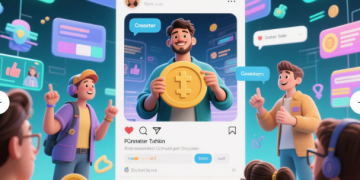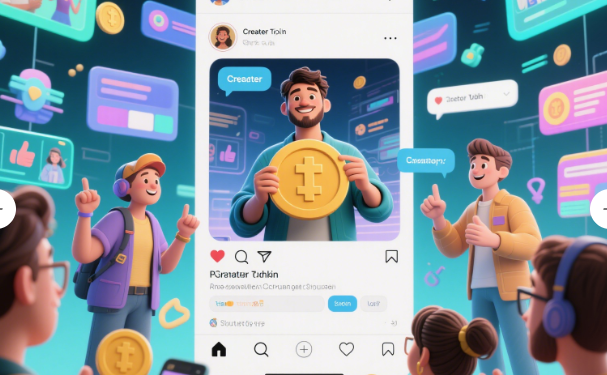In the decentralized era of Web3, Creator Tokens are emerging as a transformative force, empowering creators to monetize their influence directly while fostering deeper connections with their audiences. These tokens, built on blockchain technology, allow artists, influencers, and entrepreneurs to tokenize their personal brand, content, or services, creating new revenue streams and democratizing access to exclusive experiences. In this article, we explore the mechanics, benefits, challenges, and future of Creator Tokens, with insights from leading platforms and expert predictions.
What Are Creator Tokens?
A Creator Token is a digital asset (typically an ERC-20, BEP-20, or BRC-20 token) issued by a creator to represent ownership or access to their work, community, or time. Unlike traditional fan clubs or paywalls, these tokens are decentralized, tradable, and programmable, enabling dynamic interactions. For example, holders might gain access to exclusive content, voting rights in community decisions, or even revenue-sharing opportunities.
Platforms like time fun and PeopleMint are at the forefront of this movement. Time fun, backed by Solana co-founders, allows creators to launch “time assets” that fans can buy to unlock DM access, video calls, or group chats. Meanwhile, PeopleMint leverages the BRC-20 standard to let creators mint tokens directly from their social media profiles, fostering a “fair launch” ecosystem where anyone can participate.
How Do Creator Tokens Work?
- Token Launch: Creators deploy tokens via platforms or self-custodied smart contracts. For instance, on time fun, creators undergo identity verification and set tokenomics (e.g., price, utility) before launching their tokens.
- Utility-Driven Demand: Tokens derive value from their use cases. Holders of R.A.C Token (a music-focused Creator Token) can attend virtual concerts or receive unreleased tracks, while Inpepe aims to become the 首选 currency for influencer-driven transactions, with projections of 2,821X growth by 2025.
- Liquidity & Trading: Tokens trade on decentralized exchanges (DEXs) like Raydium or centralized platforms. Time fun’s tokens, for example, migrate to DEXs once their market cap hits $100,000, ensuring liquidity for both creators and investors.
The Benefits of Creator Tokens
1. Direct Monetization Without Intermediaries
Creators retain full control over their revenue, bypassing platforms like Patreon or OnlyFans that take hefty commissions. On time fun, creators earn from token trading fees and direct interactions, with 94% of USDC from DM/meeting payments going to them.
2. Community-Driven Growth
Tokens align incentives between creators and fans. Holders become stakeholders, amplifying content reach and loyalty. Projects like Whale use tokens to fund NFT purchases and community initiatives, creating a self-sustaining ecosystem.
3. Programmable Utility
Smart contracts enable innovative features. For example, a Creator Token could automatically reward long-term holders with discounts or early access. B.20, a token fractionalizing Beeple’s NFTs, allows partial ownership and entry into exclusive Discord communities.

Challenges in the Creator Token Ecosystem
1. Regulatory Uncertainty
The SEC’s classification of tokens as securities or commodities remains ambiguous. Projects like time fun mitigate risks by acting as “Token Creators,” handling legal compliance on behalf of creators. However, global regulatory disparities (e.g., China’s tokenization market projected to reach $811.8M by 2030) complicate cross-border adoption.
2. Market Volatility and Speculation
Many Creator Tokens are speculative, with prices driven by hype rather than utility. For instance, Friend Tech’s collapse in 2023 highlighted the risks of unbacked tokens. Platforms like time fun address this by implementing reputation systems (e.g., reply rates and user ratings) to align token value with creator performance.
3. Technical Barriers
Creating a Creator Token requires blockchain literacy. While platforms like PeopleMint simplify minting, integrating tokens into existing workflows (e.g., social media, email marketing) remains challenging.
Case Studies: Innovations in Creator Token Use Cases
1. time fun: Time as a Currency
By tokenizing creators’ time, time fun enables micro-interactions like paid DMs or consulting sessions. Solana co-founder Toly’s token, for example, lets holders book 1:1 calls, blending personal branding with DeFi.
2. PeopleMint: Democratizing Token Creation
PeopleMint’s BRC-20 infrastructure allows anyone to mint a Creator Token linked to their social media handles. This “fair launch” model reduces barriers to entry, with projects like $PPLM gaining traction as a “socialfi” governance token.
3. Inpepe: Influencer-Driven Memecoin
Inpepe aims to become the backbone of the $480B influencer economy by 2027. Its tokenomics include staking rewards and partnerships with TikTok/YouTube creators, positioning it as a utility-focused meme coin.
The Future of Creator Tokens
1. Mainstream Adoption
As blockchain infrastructure improves (e.g., Ethereum’s EIP-1559 reducing gas fees), Creator Tokens will likely integrate with Web2 platforms. Twitter’s “Tip Jar” feature, for example, already lets users tip creators in Bitcoin.
2. Cross-Chain Interoperability
Projects like LayerZero and Polkadot are enabling seamless token transfers across blockchains. This will allow Creator Tokens to operate on multiple networks, expanding their user base.
3. Regulatory Clarity
The SEC’s 2025 guidelines on crypto ETFs and token classification could legitimize Creator Tokens as a viable asset class, attracting institutional investors.
Conclusion: Bitora’s Role in the Creator Token Revolution
As the Creator Token ecosystem evolves, platforms like Bitora are essential for staying informed. Bitora’s comprehensive news, analytics, and market insights empower creators and investors to navigate this dynamic space. Whether you’re launching a token, analyzing trends, or exploring partnerships, Bitora’s tools provide the edge needed to succeed in Web3.
Stay ahead with Bitora—your gateway to the future of creator economies.



























